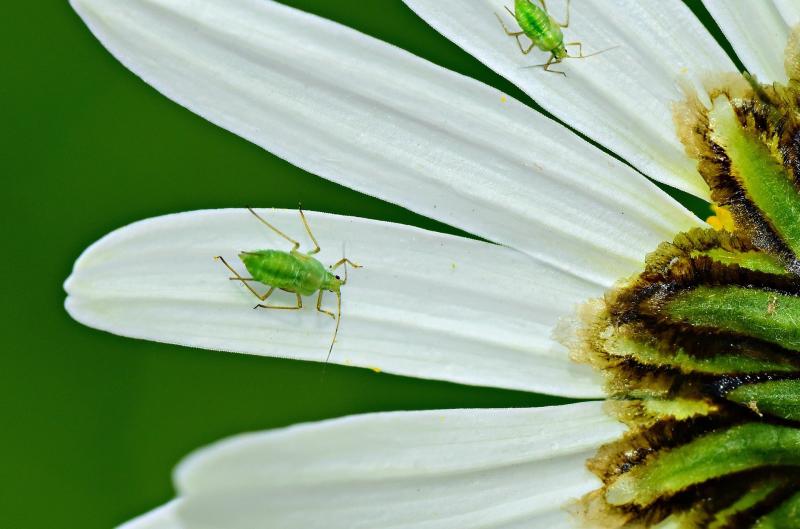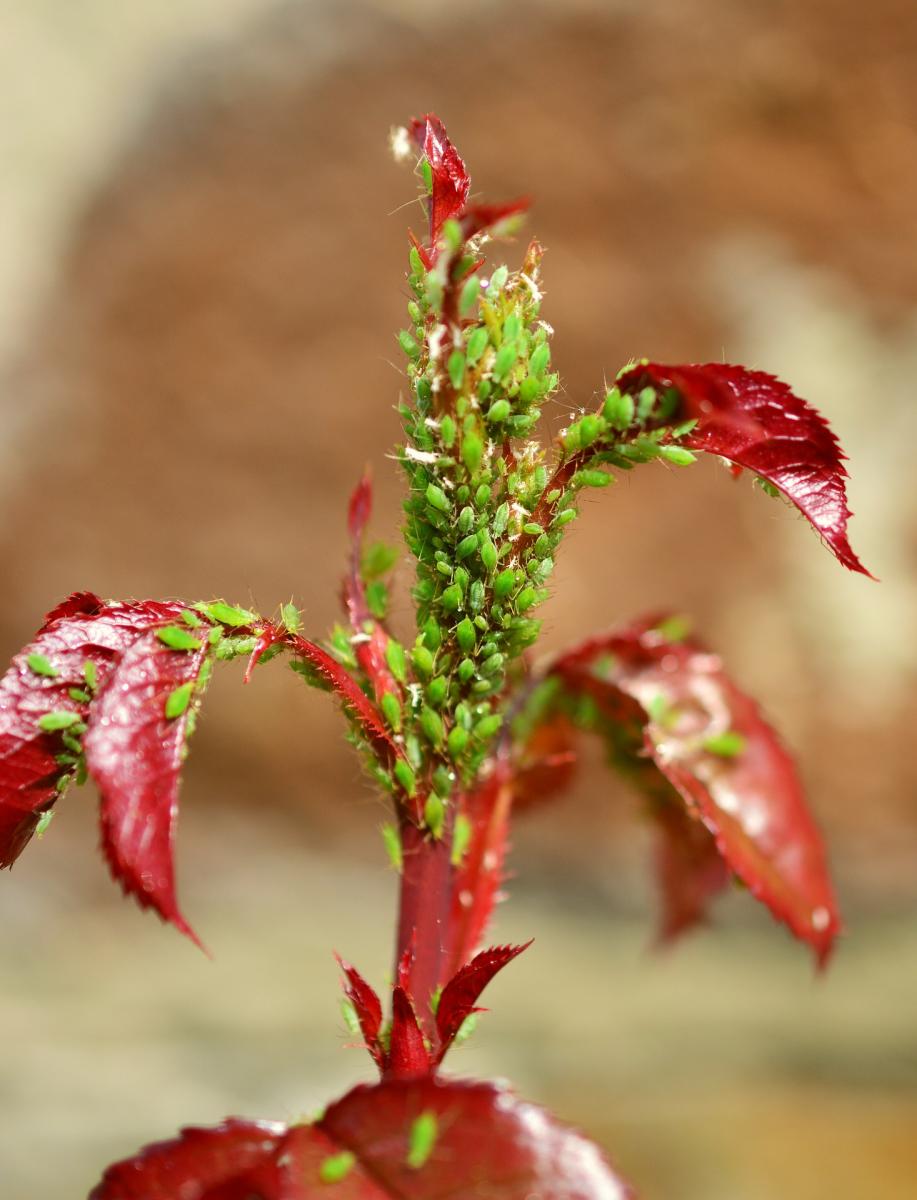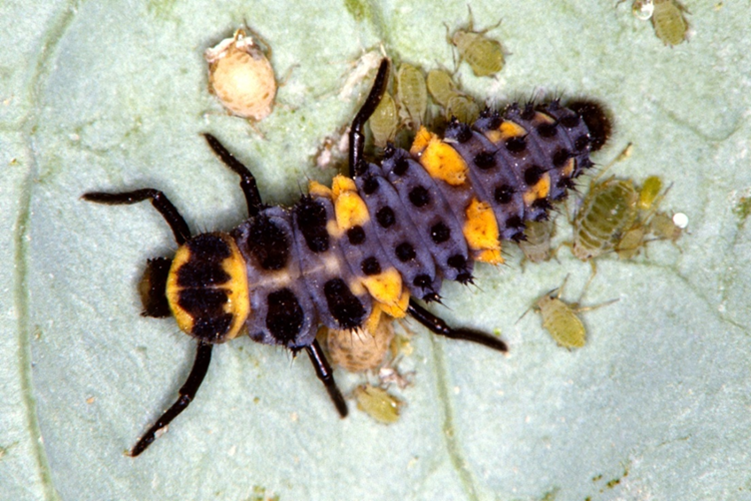
This spring, there have been many questions about something sticky falling from trees. There are a couple possibilities for this phenomenon, but a common culprit this year seems to be a higher-than-normal number of aphids.
 Aphids are very small soft-bodied insects, typically 1/16 to 1/8 inch in length. They have a mouth like a straw, which is inserted into plant leaves or stems and the liquid contents ingested. They are oval shaped, with a pair of short tail-pipe structures, called cornicles, protruding from the upper surface of the abdomen near the tail. They can be many colors – pale yellow, green, orange and early black; some are even bright red.
Aphids are very small soft-bodied insects, typically 1/16 to 1/8 inch in length. They have a mouth like a straw, which is inserted into plant leaves or stems and the liquid contents ingested. They are oval shaped, with a pair of short tail-pipe structures, called cornicles, protruding from the upper surface of the abdomen near the tail. They can be many colors – pale yellow, green, orange and early black; some are even bright red.
There are about 1,350 aphid species in North America, with over 5,000 worldwide. Whitney Cranshaw, Colorado State University entomologist, estimates there are over 350 aphid species in Colorado, so we could expect a similar number in Nebraska. Most aphid species are host specific and feed on only a few types of plants, but others are more generalists feeding on a large variety of plants.
Aphid Damage & Honeydew
Small numbers of aphids are normal, kept under control by natural enemies, cause little to no significant plant damage and don’t require control. But large number of aphids feeding on plant shoots or buds can cause leaf yellowing and curling, followed by wilting, premature leaf browning and death of shoots or buds. In evergreens, large aphid infestations can result in branch dead.
They also secrete honeydew; excess plant sap which contains plant sugars. Honeydew falls to any surface below the infested tree. Lower leaves, as well as cars, patios, tables or chairs, are coated with this sugary liquid, which eventually dries into a shiny, sticky coating. Later in the summer, the honeydew is often colonized by a black sooty mold, turning plants or surfaces black.
Lifecycle
Almost all aphids are females. If male insects are produced, it is only in late summer or early fall. Adult females give live birth to genetically identical daughters and are capable of producing 3-5 young per day - talk about cloning yourself! Each immature aphid grows quickly, reaching adulthood in 10-14 days.
 Management
Management
Small numbers of aphids should be ignored. Allow natural predatory insects to do their job. Aphids have many natural enemies, a few of these include ladybug adults; the immature stages of ladybugs, lacewings and flower flies; and parasitic wasps.
Syringing, or knocking aphids off plants with a strong spray of water, is a good mechanical technique to reduce insect numbers. This will also help wash honeydew and sooty mold off plants. Repeat the syringing as needed to keep aphid numbers under control. Aphids are not strong insects and can easily be washed out of plants by a strong rainstorm. Gardeners may notice more aphids during periods with little rain.
If insecticidal control is needed, protect natural predatory insects and pollinators by first using low risk pesticides like horticultural oil, insecticidal soap or neem (azadirachtin).Even though these are low risk pesticides, they can still cause plant damage if used incorrectly. Don't spray any pesticides when air temperatures are above 85 F. Read and follow all product label directions.
If stronger, residual insecticides are used they can provide control for a week or more, but they will also kill many beneficial insects, such as pollinators and the natural aphid enemies mentioned above. Do not spray these products on trees or shrubs while they are blooming. Traditional insecticides include acephate, permethrin, bifenthrin, lambda-cyhalothrin, cyfluthrin and malathion.
 A majority of aphids feed on the underside of leaves, so be sure to spray both the surface and undersides of leaves. Pesticides must contact the insects to kill them, so thorough coverage of the plant is required. Repeated applications will be needed when aphid numbers are high.
A majority of aphids feed on the underside of leaves, so be sure to spray both the surface and undersides of leaves. Pesticides must contact the insects to kill them, so thorough coverage of the plant is required. Repeated applications will be needed when aphid numbers are high.
Systemic insecticides, including imidacloprid and dinotefuran, can be applied to trees and woody plants as a soil drench. The chemical is taken up by plant roots and transported throughout the plant. This process can take 2-4 weeks, depending on the size of the plant. But when the insecticide reachs a toxic level, aphids will be killed as they feed on leaves, stems and branches.
Natural aphid predators will not be directly affected by systemic insecticides, but these products do move into the pollen and flower nectar of treated plants, so are toxic to pollinators.
As always, follow all pesticide label direction for application and use, including restrictions on plants where these products should not be applied.
Images
- Aphids have an oval shaped body with two conicles projecting from their upper abdomen surface near the tail. Image from Pixabay.com.
- Aphids infesting a rose shoot. Image from Pixabay.com.
- Ladybug larva look very different than adults, but feed voraciously on aphids. Jim Kalisch, University of Nebraska entomologist retired.
- Adult ladybugs help keep aphid numbers under control. Image from Pixabay.com.